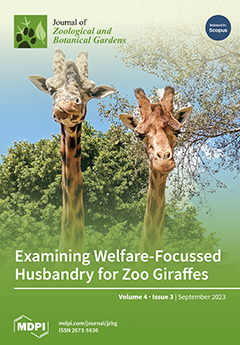Measurement of zoo animal welfare states enables improvement to husbandry and management to be evidence-based and implemented according to species’ needs. Theoretical welfare concepts are often discussed, and whilst it is helpful to ensure wide consensus across all stakeholders on what welfare comprises,
[...] Read more.
Measurement of zoo animal welfare states enables improvement to husbandry and management to be evidence-based and implemented according to species’ needs. Theoretical welfare concepts are often discussed, and whilst it is helpful to ensure wide consensus across all stakeholders on what welfare comprises, practical application of such evidence-based information is as equally important. All species housed in zoos will have specific needs that must be met by their housing, husbandry, and care to enable them to thrive. Therefore, this paper examined how to identify key animal care needs and an animal’s responses to them to form a basis for species-specific welfare assessment approaches. There are examples of familiar-to-the-zoo species that still pose challenges regarding delivery of optimal husbandry and management. As such, the identification and evaluation of core concepts of the biology, behaviour, “needs and wants” of these species is required to support validation and refinement of physical, behavioural, and psychological welfare measures. This article evaluated the use of evidence to build capacity in welfare measurement for a familiar zoo-housed species, the giraffe (
Giraffa camelopardalis, Linnaeus 1758), by outlining seven key needs and requirements that must be provided in the zoo (“giraffe W-E-L-F-A-R-E” = Warmth, Enrichment, Leaves, Feeding, Alfalfa, Rumination, Exercise). Provision of these inputs, and opportunities for all giraffes in a herd to engage with them, provides the foundation for further welfare assessment to be implemented. Specifically, the validation and measurement of mental states that are more likely to be positive if key behavioural and ecological needs have already been met. This paper advocated for this evidence-based approach to “welfare-focussed husbandry”, with distillation of key information that supports species-relevant care, to be developed for other zoo-housed species as support for their welfare assessment protocols. Such welfare-focussed husbandry is layered on top of the basic animal care requirements of the species in the zoo to ensure all individuals have the best opportunity to attain positive welfare states. In this way, and once validated, foundational welfare assessment can be easily completed by busy animal care staff, capacity is built into zoo operations as all stakeholders are aware of exactly what each species needs, and deeper dive welfare assessment (especially concerning animal mental states) can be targeted more effectively. Further evolution of these seven steps for the giraffe is suggested and extrapolation of this approach, to aid identification of key welfare indicators across all zoo-housed species, is encouraged.
Full article





